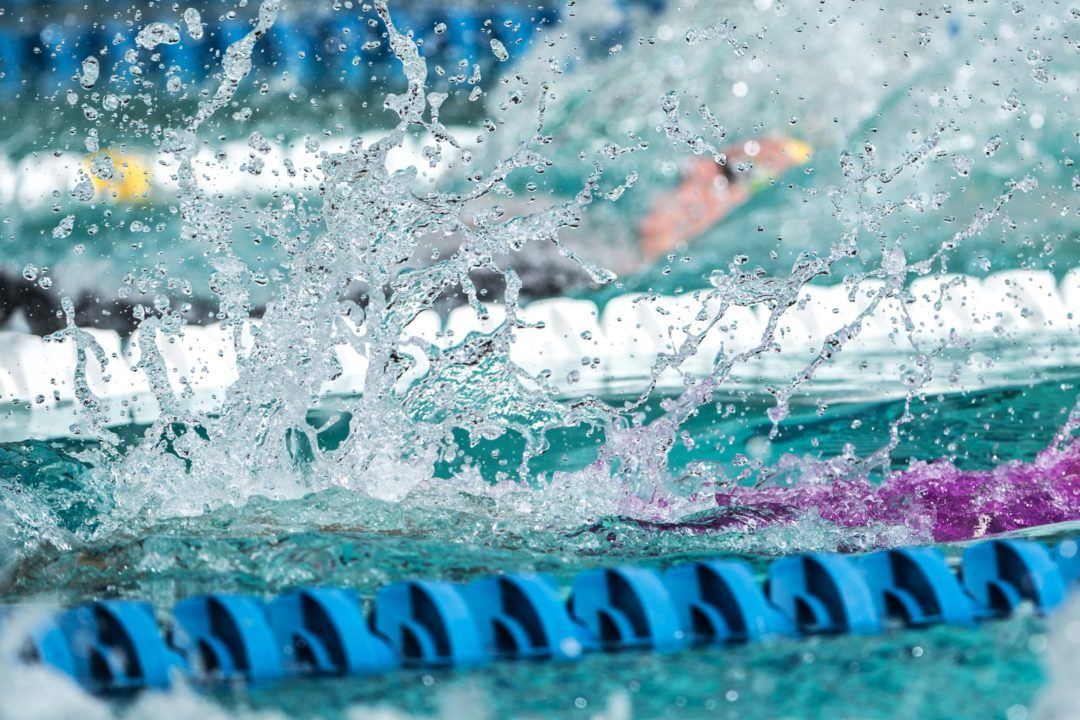John Culhane swam for William & Mary, and has been swimming in masters and open-water races ever since. He teaches at Delaware Law School, and is a columnist for the on-line magazine Slate. His two daughters swim for the Friends Select Swim Team in Philadelphia.
As the parent of 11-year-old swimming twins, and as a life-long competitive swimmer myself, I am well aware of the many good things the sport offers. Readers of this story don’t need a refresher on that topic, but for me, anyway, the sport’s benefits include: teaching the value of goal-setting, and of learning to deal with both success and failure; learning to love exercise for its own sake and developing a life-long love of the water; exposing the children to one of the few sports where boys and girls train and compete together; and teaching them the value of teamwork.
But that final benefit has been watered down (sorry!) by the way swim meets are conducted today. And that brings me to the first on my list of simple things that could be done to make our sport even better:
1. Bring back the relays! In the three years that my kids have been competing in our local USA Swim meets, only one non-championship meet has offered these team-building events. What’s that about? Many kids swim out-of-their-minds fast on relays, and working on exchanges during practice is a concrete way to show the value of teamwork. Not to mention the roof-raising cheers that only relays engender, as the kids can put aside their own rivalries and get behind each other, fully.
The only answer I’ve gotten is that, at least in our Mid-Atlantic region, the meets are so stuffed that there’s no time for relays. But who says that every event needs to be offered for every age group, at every meet? Run a sprint-only meet, with a full complement of 4 x 50 relays. Run a distance meet with 4 x 200 freestyle relays (and 4 x100 for the 10 and under age group). This isn’t complicated.
2. On the subject of team-building: Whatever happened to dual meets? Y teams understand the importance of these events, where team totals take precedence over individual efforts, but most teams in our area — including ours — have no dual meets at all. Many of the kids who finish, say, 83rd at a USA meet, can feel like real contributors in the dual meet setting. They shouldn’t have to wait until high school to experience the high of beating their arch-rival team in a meet that comes down to the last relay.
3. This is the most radical of the suggestions, and the only one that would require a change at the national level: At least for the lower age levels, move from two-year to single-year groups. It is just nuts for a girl or boy who has just turned 11 to be ranked against a foot-taller, post-pubescent kid whose 13th birthday is a week away. In fact, USA Swimming recognizes that there’s a difference, because they already publish “motivational times” for single ages. Competition and time standards for championship meets should both be divided in this way.
What I’m proposing is actually a simple step that would add almost no time to meets (one or two extra heats, at most, spread over what is now one age group), and would provide further incentive to kids trying to reach their goals.
As we know, swimming is a challenging sport that requires an astonishing level of commitment, involves lots of pain, and invariably brings disappointment at some point (no matter who the swimmer). The steps I’ve outlined above are all geared to counter all that by adding one vital ingredient: fun.


Love the relay meet idea. Mixed relays too!
I would like to see USA Swimming out some restrictions on practice time for age groupers – at least under HS age. No two-a-days for kids that age.
Relays are great team builders, we need more meets with relays so kids can work together. In our state meet each team only get one relay. This means the swimmers at the bottom of their age group don’t have a chance to be on a relay at state. A qualifying time for relays would have to be set up but if the younger swimmers are good enough they should have a chance to be on a relay. Logistics shouldn’t be the reason they can’t swim, like the meet is too big.
Great thoughts. Thankfully we swim through a Y/USA club, so we have dual meets, with relays, throughout the season and I can’t think of any invitational we’ve been to that didn’t have relay’s.
I like #3, however, I would want it legislated that you can “swim up” if your times meet some intermediate standard. My son has always been outperforming his age group and just finally turned 15 so this is no longer an issue for us. It was tough enough for him as a 13 year old winning the final heat by seconds. Now at 13 he’s going to lose even the 14 year olds to swim against.
Single-year brackets are motivational for some and I agree with… Read more »
Ok this is out in left field but how about treating age group swimming like Bob Warner football…size and weight. I know it’s totally crazy and not really doable but how nice would it be to have the “giant” kids swim with kids the same size and have the late bloomer smaller kids competing with similar sized kids.
Duel/Tri meets on a fast paced high school format would be a great addition also. Our small swim club does these quite regularly. Some are official and others are not. It’s just a nice way to get the kids racing. First time I attended I was blown away by how much fun the kids were having and how short the meets… Read more »
Time Standard Meets – rather than dividing swimmers by age, meets that organise time trials by time standards (motivational times) provide for an excellent racing opportunity for ALL. Making them gender neutral would add even greater competitiveness to the mix. We did this at Glenmark Aquatic Foundation (India) and the results were very satisfying. Firstly, everyone got to race since the scatter in each time trial was narrower. And since the target was to achieve the next higher time standard, competition was relatively stress free (in comparison to most Indian age group meets that offer medals as rewards).
The concept of swimming as a team sport is a very important one and I suppose one of the reasons why the… Read more »
Don’t allow Zones for 10/Under. It’s just the bigger/stronger that go or the early developers that train too hard for their age.
And more parent education for Age group swimmers’ parents and even the kids. Too many big – headed Age Group Stars overtraining to “make cuts” or set records — only to plateau and slow down in High school, when it matters more – or drop out due to burnout, injury, or depression when late blooming peers get faster.
Usually when there is a Title of “Modest Proposal” I get all excited for a Swiftian piece of satire.
Thanks for all of the thoughtful comments. I’ve emerged with a better understanding of the economic decision-making, but I still think meet organizers could be more creative (along the lines suggested by KT12). I stand by the suggestion of going to single ages rather than two-year age groups. I was surprised to learn that this had been tried. To me, the question isn’t whether times came down but whether more kids stayed in the sport longer…. Even if that didn’t happen, I am having trouble seeing the downside here. Getting kids used to losing? Please. That’s every swimmer’s constant experience.
In Ilinois the State meet and relays are no fun. When one team has A-F relays pulling from all area is the state and claiming to be “one team” no one else has a chance. All large meets are a forgone conclusion. The super teams have ruined Age Group swimming in this state. Kids who have barely met swimming together?
I think that’s a problem, but a different one — of which the stacked relays are just a symptom.